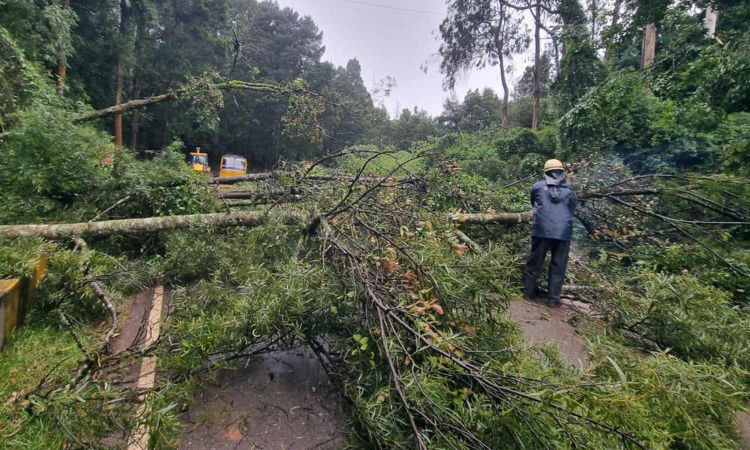Tamil Nadu: Rampant use of herbicides blamed for surge in tree falls
Inclement weather led to the collapse of 95 trees within five days, an unusual phenomenon in May. Most of the fallen trees were exotic ones like eucalyptus

Trees that fell in different parts of Nilgiris during rains
COIMBATORE: In recent rains, more than a hundred trees collapsed across the Nilgiris district, blocking roads and damaging infrastructure.
“It’s unusual for so many trees to fall in May, when rains are sparse in the hills. This time, the extreme inclement weather led to the collapse of 95 trees within five days from May 25 to 30. Most of them were exotic ones like eucalyptus trees,” said P Krishnamurthy, District Fire Officer in the Nilgiris.
In addition to the fire and rescue department, the highways, forest department, local bodies, State Disaster Response Force (SDRF), and National Disaster Response Force (NDRF) teams have also attended to calls on tree falls, thereby increasing the number of tree fall incidents.
Of the total tree fall cases reported, almost 90 per cent were attended by personnel from the fire and rescue stations located in Coonoor, Gudalur, Udhagamandalam and Kotagiri areas.
Mainly Ooty, Gudalur, Kundah and Pandalur taluks bore the brunt of tree falls, while Coonoor and Kotagiri suffered minimal impact.
“At Ooty and Kundah Taluks alone, we have attended to over 67 calls on tree falls in a week during the recent rains. Over a period of time, the weak and dangerous trees along road sides were identified and axed down. Yet, rains accompanied by strong winds triggered a surge in tree falls,” said S Sridhar, Station Officer, Ooty Fire Station.
Trees that fell in different parts of Nilgiris during rains
Even though the heavy spell of rains has now ended, giving the much-needed break to the rescue personnel, rains continue to pour on and off in certain parts of the hills. Further, the onset of the southwest monsoon is likely to cause another round of tree falls.
A common reason attributed by environmentalists to such a large number of trees falling is indiscriminate concretisation and cutting of hills for road expansions in the name of development in the hills.
“Rampant usage of herbicides by farmers in plantations causes soil to become porous and loosened. As the soil loses its strength and withholding capacity, exotic trees like eucalyptus and wattle that do not have deep roots, unlike the native ones, tend to fall off. The herbicides used by farmers usually get washed down by rain, causing weakening of the earth along road sides. Hence, those trees on roadsides get uprooted easily during prolonged rains, when the soil remains wet. An immediate solution to the issue is to cut down trees along roadsides that have grown slanting and remain dangerous by posing a risk of falling. There is a possibility of more tree falls to happen in the ensuing monsoon as soil is already damp in the current rains,” said Dr S Rajan, a retired scientist and head, Ministry of Ayush, Government of India.
Pointing to the court ruling on the removal of exotic trees, Rajan demanded their axing down in a gradual manner, besides removing the weak trees grown along road sides in the hill district.



